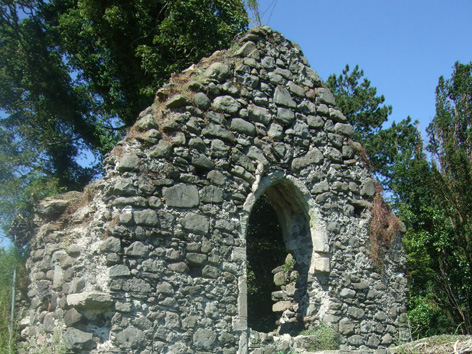
Glynn Old Church and Churchyard
History of site
This is among the oldest ecclesiastical sites in east Antrim. St Patrick is said to have founded a church in the valley of Gleannindeachta, or Glynn. The papal taxation of 1306 valued the rectory of Glynn at 5 marks and the vicarage at 10 shillings.
In the early 1600s, the Reformed Church took ownership of medieval parish churches throughout Ireland and used them for Protestant worship. According to the 1622 visitation, the pre-Reformation parish church here had been partly repaired. Later seventeenth-century surveys report that the church was in ruins, a condition in which it continues today.
The old church
The ruins of the old church are substantial and consist of a structurally divided nave and chancel. This is unusual, as most medieval parish churches in Ulster had no such division. The chancel is also long in comparison to the nave. Differences in masonry suggest the chancel may have been added at a later date – possibly the fourteenth century.
Recent conservation works uncovered evidence of an earlier window in the south wall of the chancel, possibly dating to the 14th century, which had been infilled by the insertion of a later window during the partial repair works to the church recorded in 1622. The side walls of the chancel were also raised at this time, which can be seen in the larger quarried stones used at the wall tops.
The new church
In 1838 the parish of Glynn was separated from Larne and Inver. Francis Willett Waterson was instituted as vicar of the Church of Ireland in Glynn on 9 August of that year. To begin with he had no church, and instead services were held in a ‘temporary apartment’ in the village of Glynn.
In 1840, a new church was built on a site at the west end of the old churchyard. A special service to mark its opening was held on Wednesday, 9 December 1840. An account of this service in the Belfast Newsletter of 15 December noted ‘the church was quite crowded and every effort was made by the congregation to accommodate those benevolent strangers who had come from a distance.’
The churchyard
The ruined church stands in the north-east section of a rectangular graveyard which was extended to the south in 1912. Though the memorials are mainly to be found on the south side of the old church, there are gravestones on all sides of the ruin, and even within its walls. On the north side of the ruined church the ground drops away quite steeply towards the lane alongside the river. Even here there are a number of headstones.
Early stones
The earliest inscriptions date from the early eighteenth century. Among these are the memorials to John McClelland who died in 1714 aged 82 and Margaret Fowlerton, who died in 1716 [1717]. From the same period is the headstone to Alexander Burges who died in 1717 aged 62, and his wife Margirie Wills who died in 1715. The reverse side of this memorial features mortality symbols – a cherub, a skull and an hour-glass.
The McCleverty family
In a small walled enclosure, abutting the exterior of the east gable, is a broken box tomb in memory of the McCleverty family, one of the most distinguished families in the parish.
Captain William McCleverty occupies a conspicuous place in maritime history, for he was part of the expedition that sailed around the world with Commodore, later Lord, Anson in 1744.
Memorials to those who died in the World Wars
A number of memorials commemorate those who died in the World Wars. Robert John Ramsay was killed in action on 18 March 1916, while Robert McFerran Adams died ‘of wounds received in action’ on 4 June 1916. During World War II, Rfn William Hall, of the 7th Battn RUR, was killed in a railway accident at Scarborough on 10 August 1943 aged 21.
Maritime associations
The churchyard contains a number of memorials with maritime associations. Several of these commemorate men who were ‘lost at sea’ including William Johnston in 1874 and Randal Brown in 1890.

